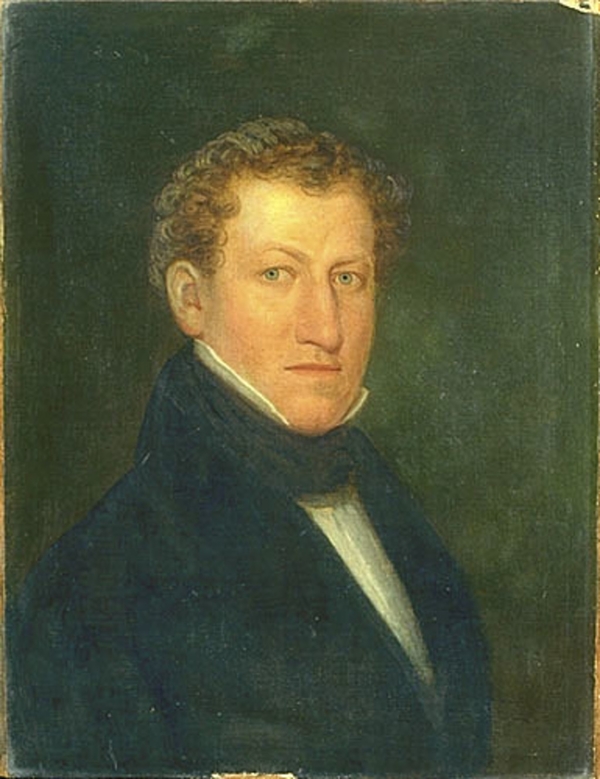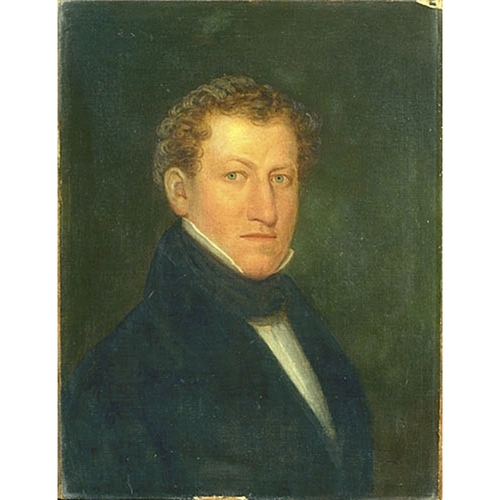
Source: Link
TRIAUD, LOUIS-HUBERT (often corrupted to Triand, Briand, Friand, and even Friend), painter, painting and drawing-master, and art restorer; b. 1790 in London of French parents; m. secondly 7 Jan. 1834 Élizabeth Pagé at Quebec; he had at least one daughter; d. there 14 Jan. 1836.
Louis-Hubert Triaud seems to have studied fine arts at the Royal Academy of Arts in London. On four occasions he exhibited works there, with a self-portrait in 1811 and with portraits of young women, two in 1818 and one in 1819. Triaud made his appearance at Quebec early in 1820. On 4 January an advertisement appeared in the Quebec Mercury announcing that he and Jean-Baptiste Roy-Audy, as “portrait, miniature and historical Painters,” will execute “any work in the above Mentioned Arts” and will teach “the Art of Drawing in all its branches, according to the method followed in the English and French Academies.” The two painters worked in close collaboration and on at least one occasion signed the same work. But no grounds exist for believing that their association lasted beyond the first three months of 1820.
Triaud soon found a patron in Abbé Louis-Joseph Desjardins, dit Desplantes, who put in a good word for him with the Ursulines of Quebec in July. Triaud worked for them, doing his most famous picture, La procession de la Fête-Dieu à Québec, en 1821. Beginning in March 1821, he also taught the nuns’ pupils for four months, giving three or four lessons weekly. According to one source the lessons were to include “sketching landscapes and painting in oils.”
Triaud was helped in his painting career by his parents’ friend Alexandre de Thémines, the bishop of Blois, France. From London Thémines wrote to Archbishop Joseph-Octave Plessis* at Quebec on 26 March 1821, describing the artist as “a young man of many talents, especially for painting.” It may have been thanks to this intervention that in 1821 Triaud did a picture for the high altar in the church of Saint-André, near Kamouraska, portraying the martyrdom of the saint. As a result of several opportunities to demonstrate his competence, his reputation grew, and Abbé Desjardins did not hesitate to put his protégé’s name forward when new commissions were being discussed. He even added that Triaud was capable of executing an excellent painting in three months.
Triaud also restored old works, notably alongside Antoine Plamondon* at Saint-Michel, near Quebec, in 1823. They were involved in “cleaning, repairing, and varnishing the four pictures in the nave of the church.” This sort of task seems in some cases to have included attaching new canvas to the picture. Triaud “repaired” canvasses for the Ursulines the following year, and in 1825 he was again paid by the nuns for similar work.
The Hôtel-Dieu was another religious institution in the town of Quebec that took advantage of Triaud’s talents, commissioning him in 1827 to paint the arms of the Duchesse d’Aiguillon, who had founded the hospital. A painting in its museum, La vision de saint Antoine de Padoue, dated 1830, bears Triaud’s signature, but documentary evidence suggests that it is a restoration, since a work with this title had been exhibited from 1818 in the chapel and Triaud received payment in 1829 to restore a picture so titled.
In 1830 Triaud successfully tried his hand at what seems to have been a genre new to him. He painted some scenery representing Windsor Castle which was to be used in a production of Richard Brinsley Butler Sheridan’s comedy The rivals at the Theatre Royal of Quebec. When the theatre was completely redone, he created a drop-scene for it, in 1832, with the help of J. F. Schinotti. Turning to ceremonial painting, Triaud in 1833 executed a work for the Confrérie des Imprimeurs de Québec to celebrate the feast-day of St Augustine, their patron saint. It was a painting on satin of a printing-press resting on a globe, the entire composition suitably inscribed.
Nothing further is known of Triaud’s professional activity, except for a few undated works. Mention should be made of a Baptism of Christ in the church at Rivière-Ouelle, a Madonna and Child at Sainte-Marie in Beauce, a portrait of Hector-Simon Huot, and a self-portrait.
In 1835 Triaud’s health was failing and he had a presentiment of his death. He passed away on 14 Jan. 1836, at the age of 46. Abbé Desjardins remembered him vividly and repeated Triaud’s advice to those dealing with the problems encountered in restoring pictures. The formulas passed on by Desjardins were so detailed that one wonders if the painter left a written description of his methods. In any case, the void left by Triaud’s death was felt particularly in the field of art restoration. “If Mr Tri Tri were alive,” Abbé Desjardins wrote to the assistant superior of the Ursulines, Marie-Louise de Saint-Henri [McLoughlin], on 19 June 1840, “he would save you a great deal of trouble.”
It is through the abbé’s correspondence that glimpses can be caught of Triaud’s personality. Desjardins called him “flighty” the first time he had occasion to mention him. Then in 1824, having enquired about his protégé’s conduct, Desjardins expressed the fear that “he flits about,” thinking it a pity that this talented man should be so irresponsible. Indeed, the painter’s finances were then in such a disastrous state that Desjardins admitted he could do nothing further to save him from his creditors. During Triaud’s death agony the abbé was astonished to see the mellowing of his character. He became “gentle as a dove, easier to attend to than a nun, and pious, almost like a hermit!”
Triaud was a figure of secondary importance in the artistic life of the capital during the second quarter of the 19th century, ranking behind Joseph Légaré*, Antoine Plamondon, and Jean-Baptiste Roy-Audy but superior to François Baillairgé* in painting. The relations between Triaud and Roy-Audy are far from clear, and were they better known, they might shed light on the question of the true paternity of certain works that are attributed to Roy-Audy. Furthermore, in the half-century between the return of Baillairgé from Paris in 1781 and that of Antoine Plamondon in 1830, Triaud was the only artist who could demonstrate to painters at Quebec, such as Légaré, artistic practices current overseas. Although he devoted little time to serious painting, Triaud had some such ambition, to judge by his 1820 advertisement. The records indicate clearly that he had taken the first steps in this direction.
Despite his love of art the flighty Louis-Hubert Triaud found living more difficult than painting, and he is still a shadowy figure. Were it not for his major work, La procession de la Fête-Dieu, he would be virtually unknown.
[The author wishes to thank Michel Nadeau for making available research essential to the writing of this biography and John R. Porter for providing references to a number of articles in newspapers of the period. d.k.]
AAQ, 90 CM, Angleterre, II: 86. ANQ-Q, CE1-1, 16 janv. 1836; CE1-64, 7 janv. 1834. Arch. du monastère des ursulines (Québec), Fonds L.-J. Desjardins, II: 34, 64; III: 27, 89. MAC-CD, Fonds Morisset, 2, dossier L.-H. Triaud. Le Canadien, 20 janv. 1836. Quebec Mercury, 4 Jan. 1820, 20 Feb. 1830, 16 Feb. 1832, 29 Aug. 1833. Daphne Foskett, A dictionary of British miniature painters (2v., New York, 1972). Algernon Graves, The Royal Academy of Arts . . . (8v., London, 1905–6). Ulrich Thieme and Felix Becker, Allgemeines Lexikon der bildenden Künstler von der Antike bis zur Gegenwart . . . (37v., Leipzig, German Democratic Republic, 1907–50). Burke, Les ursulines de Québec, vol.4. B. S. Long, British miniaturists (London, 1928).
Cite This Article
David Karel, “TRIAUD (Triand, Briand, Friand, Friend), LOUIS-HUBERT,” in Dictionary of Canadian Biography, vol. 7, University of Toronto/Université Laval, 2003–, accessed January 22, 2025, https://www.biographi.ca/en/bio/triaud_louis_hubert_7E.html.
The citation above shows the format for footnotes and endnotes according to the Chicago manual of style (16th edition). Information to be used in other citation formats:
| Permalink: | https://www.biographi.ca/en/bio/triaud_louis_hubert_7E.html |
| Author of Article: | David Karel |
| Title of Article: | TRIAUD (Triand, Briand, Friand, Friend), LOUIS-HUBERT |
| Publication Name: | Dictionary of Canadian Biography, vol. 7 |
| Publisher: | University of Toronto/Université Laval |
| Year of revision: | 1988 |
| Access Date: | January 22, 2025 |



